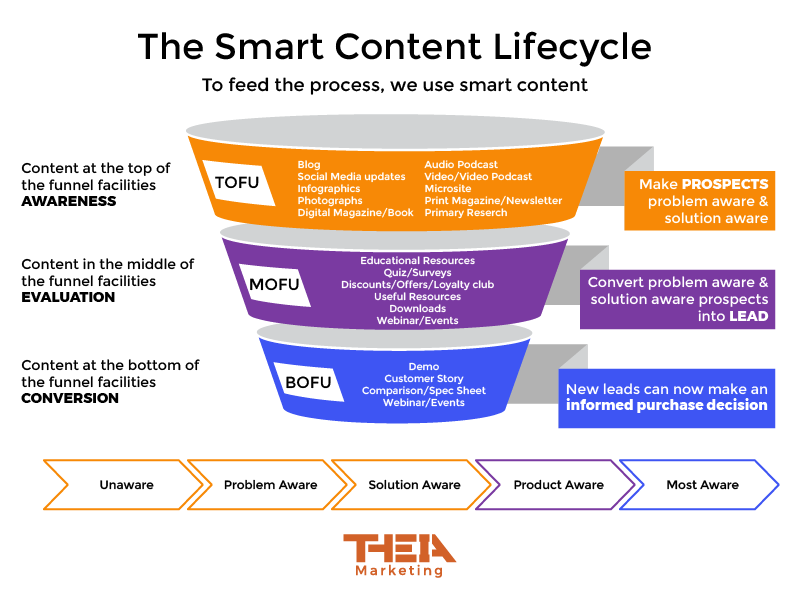Marketing and sales are two different departments.
But they have a closely intertwined connection.
Actually, when content marketing and sales work together, you’re more likely to meet and exceed your revenue and growth goals.
- B2B organizations with tightly aligned sales and marketing operations achieve 24% faster three-year revenue growth and 27% faster three-year profit growth according to Sirius Decisions.
- Sales and marketing alignment can help your company become 67% better at closing deals according to Marketo.
- Organizations with tightly aligned sales and marketing functions enjoy 36% higher customer retention rates according to Marketing Profs.
1. Use sales calls for marketing content creation
Your sales team is in a good position to help you with every stage of the customer journey, or client buying process. They hear objections and problems that prospects have with your service. It helps for them to create content addressing the problem, instead of verbally responding to the same objections again. They can give this content creation to the marketing department if they think it is a good blog post.
Content that can address objections can be found in blog content, or the Knowledge Base or “Help” section of your website. An external process can be found on the Help section; for example, your onboarding process can be put on the Knowledge Base.
Marketers can watch previous Zoom meeting to watch replays of sales demos, which can give ideas for blog posts, FAQs in the Knowledge Base, or gated content such as white papers or webinars.
2. Look at sale’s content assets
An effective sales team will use some content to generate and close leads. You can use the same language a prospect is using to describe their concerns and questions. This is a great copywriting technique for increasing conversions and sales.
According to Sirius Decisions, up to 70 percent of marketing content is unused in the sales funnel. Content marketers create content that doesn’t engage prospects.
Webinars, case studies, and white papers are great as gated content. With gated content, leads give you their email after going to a landing page for that content.
The sales team can give your marketing agency content recommendations for every stage of the client buying process. This will help your marketing agency create content that will make the customer journey successful and push them down the sales funnel.
3. Send sales leads to the marketing team
Sales teams can have prospects that turn into leads, through creating their own prospecting list of key buyer personas, companies that sell leads, or an in-person event. After several follow-ups and conversations with these leads, they may still not be ready to buy yet.
Sales should not discard them as bad leads! Instead, they should send the list over to marketing for nurturing. A Forrester report shows that 82 percent of customers viewed five or more pieces of content from the winning company before making a purchase. Remember that those leads need content for their unique stage in the client buying process, or customer journey, for nurturing.
Cold-calling works, but many leads do not want to talk to a salesperson during the awareness stage. Just 19 percent of buyers, according to HubSpot want to talk to a salesperson during this stage.

This is not the case with inbound leads, who are automatically put in a lead nurturing process, which may include sales calling within a day. They are continued in a lead nurturing process, sometimes for years, before they’re ready to make a purchase.
4. Sales helps in creating better buyer personas
Buyer personas, or your ideal client profile, helps you to determine who your target market is. Here are the top 10 questions to create a buyer persona:
- What is their biggest problems and challenges in their job?
- What would happen if they didn’t invest in your service?
- How do they get information? Blogs, books, white papers?
- What conferences do they attend?
- How do they convince their boss to make a buying decision?
- What social media and media do they consume, such as YouTube videos, podcasts, LinkedIn?
- In which industry or industries does your company work? An example is they are in the environmental services industry for education and medical customers.
- What is the size of company in terms of revenue and employees?
- What is your job role? Your title?
- How is your job measured?
Without personas, you will probably be creating content you think your audience wants, but not the content they really need that addresses their concerns and problems.
Watch replays of sales calls and take notes. You can notice common objection to purchasing your services, or challenges your prospects have. This will help with fleshing out a buyer persona.
The HubSpot Buyer Persona tool can help with making a good buyer persona for you.
Remember to visit your buyer personas at least annually to make sure you’re still producing content that resounds and engages with your buyer personas or ideal client profile. Companies that exceed lead and revenue goals are 2.2X more likely to have and document personas than companies that miss these targets, according to the 2016 Cintell study.
Your sales process can actually help your marketing process.




